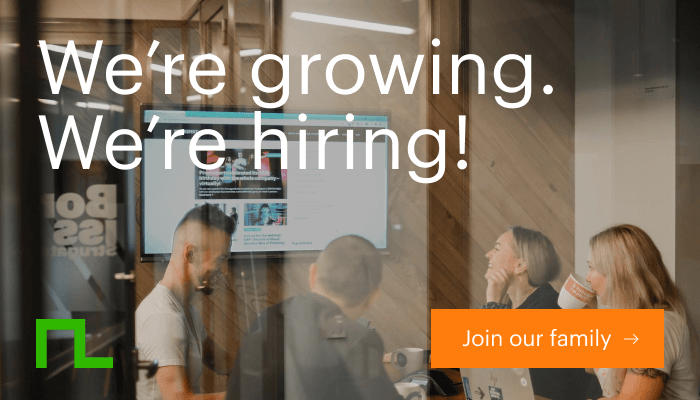Is digital business transformation putting the customer experience first?
The purpose of digital business transformation should be to enhance customer and employee experience. Building services per user needs gives no reason for your customers to look elsewhere.

Digital technologies – and how we utilize them personally, at work, and within our communities – have changed the face of business.
But, the speed at which it occurs is faster than an organization’s pace.
The digital transformation market is worth $880.28 billion. Global spending on digital transformation is expected to hit $3.4 trillion by 2026. 74% of organizations consider digital transformation a top priority.
What is digital business transformation?
Digital business transformation exploits digital technologies and supporting capabilities to create a robust new digital business model. COVID-19 forced organizations around the globe to speed up digital initiatives to drive their response to the crisis. Now, the C-suite focuses on prioritizing investments in the right initiatives to fuel future growth.
But is this digital business transformation priority actually putting the customer experience first?
Why digital transformation is essential for business growth
Digital business transformation is a method of exploiting digital technologies and their supporting capabilities to generate sound new digital business models.
Digital changes in society are highly disruptive, causing us to shop, interact, and do business differently with organizations. Now, we can do everything in a digital space, sign documents, gain education, and coordinate teamwork.
No company, industry, or area of society is unaffected.
Rather than stand still, businesses have sought to transform to gain a competitive edge. To do this, companies try to modify either several components of their business or only one part. Despite there being a lot of emphasis on the distal aspect, the key is not to forget that it is a transformation after all.
These areas for digital business transformation include
- Business processes. One or several connected operations or activities that achieve specific business goals. Business process reengineering is essential to improve internal or customer-facing aims.
- Business areas. From human resources, sales, marketing, operations, finance and administration, and customer service.
- Business models. How a business functions, from its go-to-market approach and value proposition to how it seeks to monetize. Transforming a business model aims to tap into new revenue streams.
- Business ecosystems. The partner and stakeholder networks of a business. Plus, it will include economic and regulatory factors that impact an organization’s ability to transform. Can a partner continue to integrate with a company that has digitally transformed?
- Business asset management. Typically, it focuses on traditional assets but also on more tangible assets like data and customers. Customers must be treated as an asset in digital business transformation.
- Organizational culture. Understand what culture is – it’s an employee’s mindset. Your culture should be agile and human-centered. Explore your employees’ pains and gains and how to listen to and understand them better. Only then is it possible to change the culture to be more customer-centric? If your employees feel cared for, your customers will feel the same.
It is a holistic transformation, including customer experience, technological innovation, and digital disruption. It is not only a buzzword.
Business transformation
Any business transformation should have a clear purpose. And that purpose should be the customer and the employee experience combined.
It is easy to see why.
When asked why digital transformation was implemented, nearly half of all organizations in a PWC report cited customer experience as the main factor.
With a better customer experience and increased profits, digital business transformation is the silver bullet to company success.
Yet, alarmingly, only 35% of the companies had achieved a successful digital business transformation. Furthermore, 78% failed to meet their business objectives.
There are several reasons this could be, including putting technology over customer experience.
Why is keeping the customer experience in mind challenging to transform a business?
It’s easy to forget the customer when attempting to transform a business.
A common problem is the scarcity of accurate customer insight.
Customer data is often trapped within business silos: sales, customer service, marketing, even finance. This data cannot be linked to create a holistic view of the customer.
A lack of usable, harmonized data leads to endless discussions about what the customer experience should be, why, and where.
As a result, digital transformation initiatives lose momentum or pivots. Judgment calls lead to futile outcomes.
Businesses view customer experience as either customer service or customer acquisition. They don’t include customer preferences that cater to continuous customer engagement.
Poor customer experience design makes the interaction a company provides its customers worse.
Efficiencies and productivity gains are the primary reasons why companies seek to digitize. But if the customer does not benefit, the organization will not either.
Ignoring a business’s customers means missing clear opportunities.
Using digital technology should improve brand awareness, customer acquisition, and customer retention – the overall customer experience.
Why is focusing on customer experience necessary for your business?
Customer experience is your customers’ perception of a business or brand.
It forms from every interaction a customer has with your business, from navigating the website to talking to customer service and receiving a product/service they purchased.
Everything (and everyone in it) a business does will impact customer perception. They are influencing a customer’s decision to keep coming back or not.
A good customer experience leads to your customers spending more. In fact, 86% of buyers are willing to pay more for a great customer experience. And according to research from PWC, the more expensive the item, the more they are willing to pay
Excellent customer experience then is a key to profitability.
Delivering a great customer experience is critical for any business. The better customers’ experience, the more repeat customers and positive reviews they will receive.
The benefits of achieving excellent customer experience include:
- increased customer loyalty
- increased customer satisfaction;
- increased positive reviews and recommendations;
- increased business profitability.
There is no single checklist to guarantee an excellent customer experience: a business is unique, and so are its customers.
Before transforming a business, an organization should consider improving the customer experience.
This approach begins with understanding how the business needs to change to deliver improved customer experiences.
Leaders, managers, and employees implement technologies to deliver customer value early on.
The customer experience should lead to digital business transformation, not vice versa.
Final thoughts on digital business transformation
Digital business transformation offers organizations an opportunity to engage modern buyers.
Companies can deliver a seamless customer experience regardless of which channel or place a customer uses.
That being said, despite the desire to be innovative, not putting the customer first risks sending them to competitors.
Digitization allows you to create an understandable, comfortable customer experience and consistent across channels, products and services.
Digitalization of your services per user needs gives no reason for your customers to look elsewhere.
Enhance your customer experience with digitalization now! Share your challenge with us.













